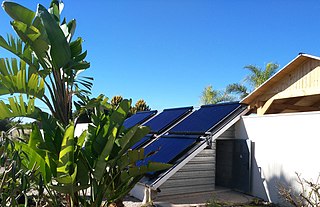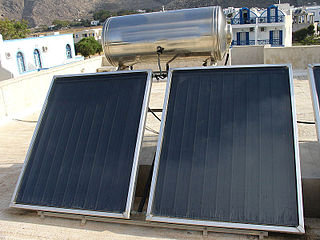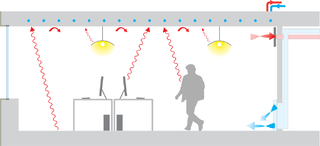SolarWall is the brand name of a transpired collector designed and manufactured by Conserval Engineering. Conserval Engineering is based in Toronto, Ontario, Canada.
SolarWall is the brand name of a transpired collector designed and manufactured by Conserval Engineering. Conserval Engineering is based in Toronto, Ontario, Canada.
The SolarWall design was developed in 1989 by John Hollick of Conserval Engineering with assistance from Natural Resources Canada and the United States Department of Energy's National Renewable Energy Laboratory (NREL). [1] [2] [3] The system consists of perforated metal panels mounted on a building's sun-facing exterior wall, the panels absorb heat from the sun and in turn heat the air space between the panel and the building's wall. The heated air is then pulled into the building's ventilation or HVAC system via a fan, saving building owners on their heating costs and reducing the amount of fossil fuels used. [3] According to Mother Earth News, for every 5 square metres (54 sq ft) of SolarWall panels installed, about 1 ton of carbon dioxide emissions is displaced each year. [2] An unglazed design is used for heating or preheating large volumes of fresh air, and a partially glazed 2-stage heater is available for achieving higher temperatures when heating buildings in colder climates. The SolarWall technology can also be installed as a hybrid solar system that generates both heat and electricity from the same surface area. By combining photovoltaics with the air heating technology, the heat produced by the solar panels is removed and drawn into the collector, helping to cool the solar panels and preheat the building's ventilation system at the same time. [4]
Compared to traditional roof-mounted solar thermal panels designed to heat domestic hot water, a vertical orientation eliminates any snow buildup and was found to increase winter solar gain, being angled more towards the lower winter solar angle. Reflective snow on the ground was found to increase solar energy as much as 50%.[ citation needed ]
Three of Conserval's early SolarWall installations have been closely monitored to determine real energy savings. In 1990, Ford Motor Company installed a system on their Oakville, Ontario manufacturing plant, saving approximately 17% on their heating costs at that plant alone. [1] The company eventually installed six more SolarWall systems on other facilities, and as of 2014 have reportedly saved more than $10 million over all their installations. [3] In 1991, General Motors had a system installed at their Oshawa, Ontario plant and, as of 1998, reported a savings of approximately $10,200 per year. Another collector installed at NREL in Golden, Colorado in 1991 is saving about 14,310 kWh of electricity annually, a reported 25.7% decrease. [1] According to Solar Energy Industries Association, over 5,000,000 square feet (460,000 m2) of these panels were in operation as of 2015.[ citation needed ]
SolarWall and its parent company Conserval have received a number of awards: [1]
An autonomous building is a building designed to be operated independently from infrastructural support services such as the electric power grid, gas grid, municipal water systems, sewage treatment systems, storm drains, communication services, and in some cases, public roads.

Solar energy is radiant light and heat from the Sun that is harnessed using a range of technologies such as solar power to generate electricity, solar thermal energy, and solar architecture. It is an essential source of renewable energy, and its technologies are broadly characterized as either passive solar or active solar depending on how they capture and distribute solar energy or convert it into solar power. Active solar techniques include the use of photovoltaic systems, concentrated solar power, and solar water heating to harness the energy. Passive solar techniques include orienting a building to the Sun, selecting materials with favorable thermal mass or light-dispersing properties, and designing spaces that naturally circulate air.

Heating, ventilation, and air conditioning (HVAC) is the use of various technologies to control the temperature, humidity, and purity of the air in an enclosed space. Its goal is to provide thermal comfort and acceptable indoor air quality. HVAC system design is a subdiscipline of mechanical engineering, based on the principles of thermodynamics, fluid mechanics, and heat transfer. "Refrigeration" is sometimes added to the field's abbreviation as HVAC&R or HVACR, or "ventilation" is dropped, as in HACR.
A Trombe wall is a massive equator-facing wall that is painted a dark color in order to absorb thermal energy from incident sunlight and covered with a glass on the outside with an insulating air-gap between the wall and the glaze. A Trombe wall is a passive solar building design strategy that adopts the concept of indirect-gain, where sunlight first strikes a solar energy collection surface which covers thermal mass located between the Sun and the space. The sunlight absorbed by the mass is converted to thermal energy (heat) and then transferred into the living space.

In passive solar building design, windows, walls, and floors are made to collect, store, reflect, and distribute solar energy, in the form of heat in the winter and reject solar heat in the summer. This is called passive solar design because, unlike active solar heating systems, it does not involve the use of mechanical and electrical devices.

Weatherization or weatherproofing is the practice of protecting a building and its interior from the elements, particularly from sunlight, precipitation, and wind, and of modifying a building to reduce energy consumption and optimize energy efficiency.

Solar thermal energy (STE) is a form of energy and a technology for harnessing solar energy to generate thermal energy for use in industry, and in the residential and commercial sectors.

Water heating is a heat transfer process that uses an energy source to heat water above its initial temperature. Typical domestic uses of hot water include cooking, cleaning, bathing, and space heating. In industry, hot water and water heated to steam have many uses.

Solar water heating (SWH) is heating water by sunlight, using a solar thermal collector. A variety of configurations are available at varying cost to provide solutions in different climates and latitudes. SWHs are widely used for residential and some industrial applications.
A solar chimney – often referred to as a thermal chimney – is a way of improving the natural ventilation of buildings by using convection of air heated by passive solar energy. A simple description of a solar chimney is that of a vertical shaft utilizing solar energy to enhance the natural stack ventilation through a building.

A solar thermal collector collects heat by absorbing sunlight. The term "solar collector" commonly refers to a device for solar hot water heating, but may refer to large power generating installations such as solar parabolic troughs and solar towers or non water heating devices such as solar cooker, solar air heaters.

Passive house is a voluntary standard for energy efficiency in a building, which reduces the building's ecological footprint. It results in ultra-low energy buildings that require little energy for space heating or cooling. A similar standard, MINERGIE-P, is used in Switzerland. The standard is not confined to residential properties; several office buildings, schools, kindergartens and a supermarket have also been constructed to the standard. The design is not an attachment or supplement to architectural design, but a design process that integrates with architectural design. Although it is generally applied to new buildings, it has also been used for refurbishments.

Sustainable architecture is architecture that seeks to minimize the negative environmental impact of buildings through improved efficiency and moderation in the use of materials, energy, development space and the ecosystem at large. Sustainable architecture uses a conscious approach to energy and ecological conservation in the design of the built environment.
Renewable heat is an application of renewable energy referring to the generation of heat from renewable sources; for example, feeding radiators with water warmed by focused solar radiation rather than by a fossil fuel boiler. Renewable heat technologies include renewable biofuels, solar heating, geothermal heating, heat pumps and heat exchangers. Insulation is almost always an important factor in how renewable heating is implemented.

Underfloor heating and cooling is a form of central heating and cooling that achieves indoor climate control for thermal comfort using hydronic or electrical heating elements embedded in a floor. Heating is achieved by conduction, radiation and convection. Use of underfloor heating dates back to the Neoglacial and Neolithic periods.

A solar combisystem provides both solar space heating and cooling as well as hot water from a common array of solar thermal collectors, usually backed up by an auxiliary non-solar heat source.

Solar hot water is water heated using only energy from the Sun. Solar energy heats up large panels called thermal collectors commonly known as solar panels. The energy is transferred through a fluid to a reservoir tank for storage and subsequent use. It is then used to heat water for commercial or domestic use and also as an energy input for heating and cooling devices and for industrial 'process heat' applications. In domestic solar hot water applications, the thermal collectors can either be coupled together with the hot water storage tank on a rooftop, or separated from the storage tank, in a "split system" configuration.

Solar air heating is a solar thermal technology in which the energy from the sun, insolation, is captured by an absorbing medium and used to heat air. Solar air heating is a renewable energy heating technology used to heat or condition air for buildings or process heat applications. It is typically the most cost-effective out of all the solar technologies, especially in commercial and industrial applications, and it addresses the largest usage of building energy in heating climates, which is space heating and industrial process heating.
The Vaillant Group is a company that develops products for heating, cooling and hot water.

Radiant heating and cooling is a category of HVAC technologies that exchange heat by both convection and radiation with the environments they are designed to heat or cool. There are many subcategories of radiant heating and cooling, including: "radiant ceiling panels", "embedded surface systems", "thermally active building systems", and infrared heaters. According to some definitions, a technology is only included in this category if radiation comprises more than 50% of its heat exchange with the environment; therefore technologies such as radiators and chilled beams are usually not considered radiant heating or cooling. Within this category, it is practical to distinguish between high temperature radiant heating, and radiant heating or cooling with more moderate source temperatures. This article mainly addresses radiant heating and cooling with moderate source temperatures, used to heat or cool indoor environments. Moderate temperature radiant heating and cooling is usually composed of relatively large surfaces that are internally heated or cooled using hydronic or electrical sources. For high temperature indoor or outdoor radiant heating, see: Infrared heater. For snow melt applications see: Snowmelt system.